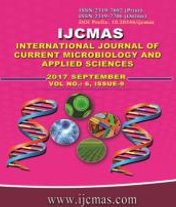


 National Academy of Agricultural Sciences (NAAS)
National Academy of Agricultural Sciences (NAAS)

|
PRINT ISSN : 2319-7692
Online ISSN : 2319-7706 Issues : 12 per year Publisher : Excellent Publishers Email : editorijcmas@gmail.com / submit@ijcmas.com Editor-in-chief: Dr.M.Prakash Index Copernicus ICV 2018: 95.39 NAAS RATING 2020: 5.38 |
Sixty genotypes of roselle (Hibiscus sabdariffa L.) were evaluated in North Coastal zone of Andhra Pradesh at Agricultural Research Station, Ragolu for fiber yield and eleven contributing characters during Kharif, 2013 & 2014 and grouped them into six clusters based on D2 analysis. Cluster I comprised of fifty one genotypes followed by Cluster II, III, IV and V with two genotypes each and the Cluster VI with a solitary genotype. Inter-cluster distance was highest between the Clusters V and III followed by Clusters V and VI and Clusters V and II; whereas Intra-cluster distance was high for Cluster I which consists of maximum number of genotypes followed by Cluster V. Cluster III recorded highest and high mean values for fiber yield and its attributing traits like dry stick weight, green weight, green weight (leafless), plant height, base diameter, mid diameter and bark thickness, whereas, Cluster V recorded lowest and low mean values for most of the fiber yield contributing traits. Fiber yield contributed high for the diversity followed by dry stick weight, green weight, plant height and green weight (leafless). The genotypes belonging to Cluster II, III, V and VI could be selected as parents in future breeding programme for developing high fiber yielding varieties.
 |
 |
 |
 |
 |